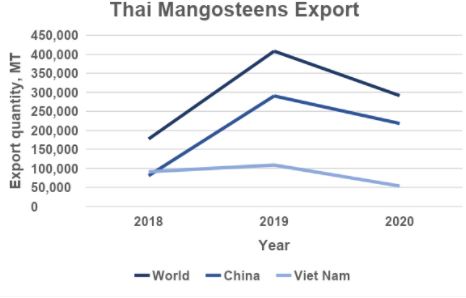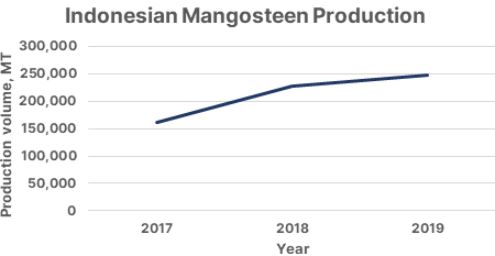A Rising Star: Indonesian Mangosteen
Mangosteen, the Queen of Fruits
Mangosteen is a tropical fruit native to Southeast Asia. Known for its exoticness, it can only be grown in a tropical climate with warm temperatures and high humidity. Main producing countries include Thailand, Indonesia, Malaysia, and the Philippines; very limited supply is produced in Central and Latin America. Though it is mainly for dietary consumption, mangosteen extract is also used in cosmetics, pharmaceutical, and food industries for its high antioxidant content. There is also an ongoing body of studies in mangosteen’s pharmacological properties, especially for its anti-cancer activities.
Current Landscape of the World Mangosteen Market
While Thailand has been the biggest supplier of mangosteens to the global trading market, its export volume in 2020 dropped by 29%, from 408,313 MT in 2019 to 291,217 MT in 2020. This may largely be attributable to China, the major importing country with a 75% import share for Thai mangosteens, temporarily stop importing Thai agricultural products during the COVID-19 outbreak in 2020 due to the closure of the country’s border. As a result, the total export volume of Thai agricultural products declined by 21-24%. Other major importing countries of Thai mangosteens are Viet Nam, Hong Kong, and Lao People’s Democratic Republic.
On the other hand, the export volume for Indonesian Mangosteen has increased by 73% from 27,797 MT in 2019 to 48,171 MT in 2020, skyrocketing by 524% from 9,189 MT in 2017 to 48,171 MT in 2020 as shown in the graph below. Some major importing countries of Indonesian mangosteen include Hong Kong, China, and Malaysia, holding a combined share of 98% of the total world import of the product; the rest of the volume goes to other countries in Asia, the Middle East and Europe, such as Australia, France, the Netherlands, Saudi Arabia, and the UAE.


Mangosteen Production in Indonesia Recovering from the Heavy Rainfall in 2020
Mangosteens in Indonesia have a long harvest season starting as early as June/July with its peak season being October to March depending on the region. The flowering of the fruit usually starts during the dry season and matures during the rainy season. Main producing regions located in western Indonesia: Sumatra, Java, and Bali.
While Indonesian mangosteen production steadily increased from 162,000 MT in 2017 to 246,000 MT in 2019, production for the last harvest season was lowered due to heavy rainfall that disrupted the flowering phase of the fruit. Higher than usual precipitation in October 2020 affected last year’s harvest, decreasing production from November 2020 through February 2021. For MY 2021/22, however, the production is expected to recover from such damage with a longer harvest season than usual.
The early harvest of mangosteens in Indonesia this year is posing a hopeful sign for Indonesian mangosteen production to recover from the last season. As of May, the harvest for this season has started early in West Sumatra and is expected to continue through mid-year until July with an estimated volume of 10,000 – 12,000 MT. The peak season in West and East Java will follow in September to add up to 225,000 MT to this MY’s production volume.

Growing Demand for Mangosteens
There is a strong demand for mangosteens in China driven by consumer’s increasing interest in potential health benefits of mangosteens and increasing income levels. Such demand is expected to recover from COVID-19 along with the country’s economic rebound.
Price Analysis: Indonesian vs. Thai Mangosteens
The current production challenge for Thai mangosteens is paving the way for Indonesian mangosteens to prosper in the export market. Although Thailand’s total fruit production for 2021 is projected to be 5.4 million MT, a 23% increase from last year, production for mangosteens is to be reduced from 337,000 MT to 315,000 MT. A recent assessment by the Ministry of Agriculture in Thailand estimated the eastern region’s mangosteen production to drop by 26%, from 212,000 MT in 2020 to 157,207 MT (estimated) in 2021. The low production is due to weather conditions that delayed the harvest, which normally starts in April.
Therefore, reduced production of Thai mangosteens has brought the price up to THB 200/kg FOB, as of May, making room for Indonesian mangosteens to compete in the export market. Prices may fall as harvest continues to add more supply through July in Thailand. Furthermore, different peak seasons between the two countries, Thailand (April to July) and Indonesia (October to March), puts Indonesian mangosteens in a favorable direction.
There is an increased demand for Indonesian mangosteens, particularly from China. According to Tridge’s Engagement Managers (EM), the price for Indonesian mangosteen continued to increase earlier this year, reaching IDR 70,000/kg FOB in March, due to increased demand in China and low availability from the low harvest resulting from heavy rain; quality issues stemming from the unfavorable weather conditions have also pushed down the total exportable quantity, further increasing the price. During the same month, with limited supply, and increased demand from China, the farmgate price rose to IDR 85,000/kg, tripling from the normal price range of IDR 20,000 – 30,000/kg.
However, this month (May 2021), the incoming supply of mangosteens with the early harvest is lowering the price to a competitive level of IDR 40,300/kg, CIF to China’s main seaports (IDR 50,000/kg in early April 2021). The price is expected to go downwards when the main harvest begins in September, offering a competitive price range for Indonesian mangosteens in the global market.
Sources:
- ITC Trade Map.
- Statista.
- Tridge Local Insights. Shelly Chen, Lena Hartanto, Rata Kirkthanasatit, Yun Primawan & Alex Yang
- Tridge Analysis. "Influence of the Coronavirus on Thai Produce: Exports of Tropical Fruits Decrease, Rice Demand Soars"
- Britanica. "Mangosteen"
- Fresh Plaza. "Thai mangosteen production 6.53% lower"
- National Geographic. "Meet the Mangosteen"
- Produce Report. "18 tons of mangosteen entered the country through Dongxing Port"
- ResearchGate. "Improving productivity and quality of Indonesian Mangosteen"
- RYT9. "Agriculture reveals the situation of fruit production in 2021 and guidelines for fruit management during COVID-19", "NESDB expects the year 64, durian-mangosteen-rambutan-longkong output in the Northern region. over 1.06 million tons"
- Thansettakij. "Eastern fruits in the year '21, the price has skyrocketed"
- Trendhunter. "Mangosteen Mania"





